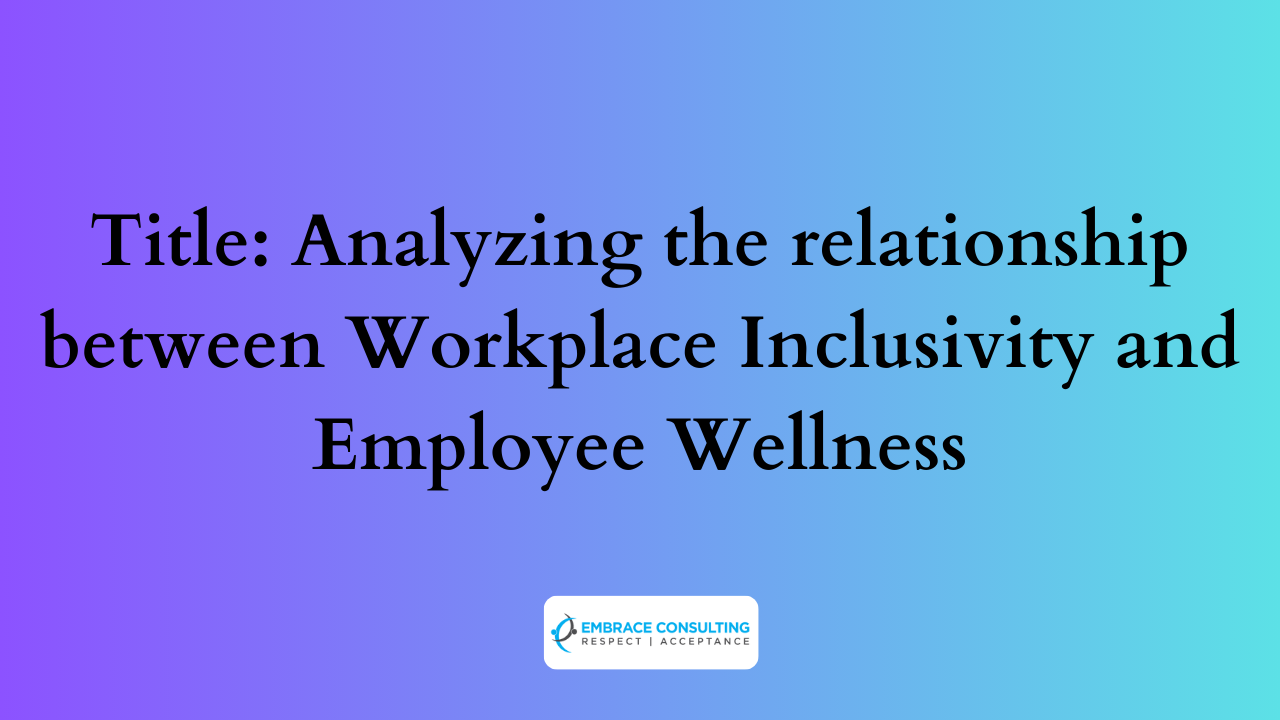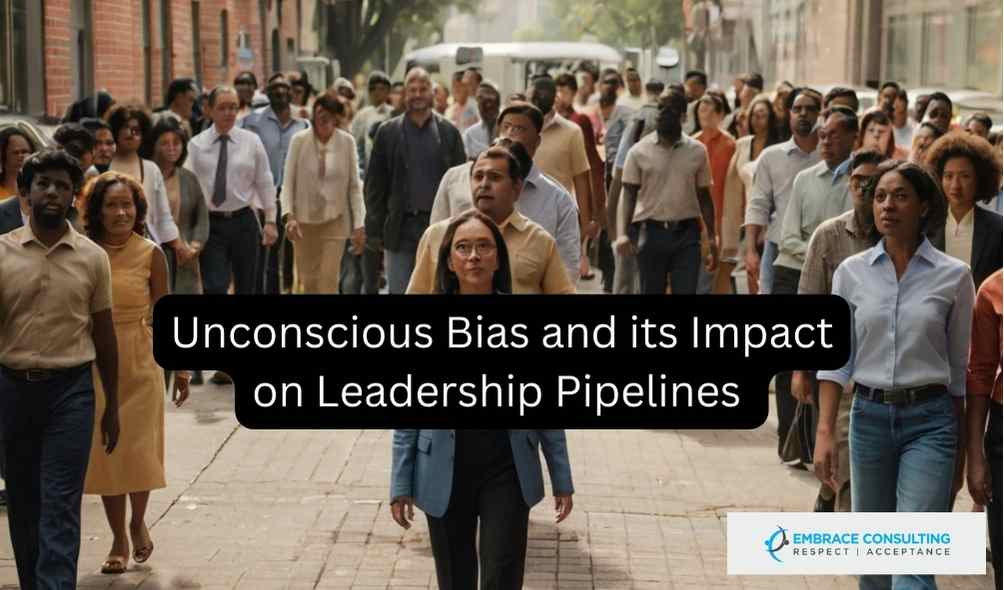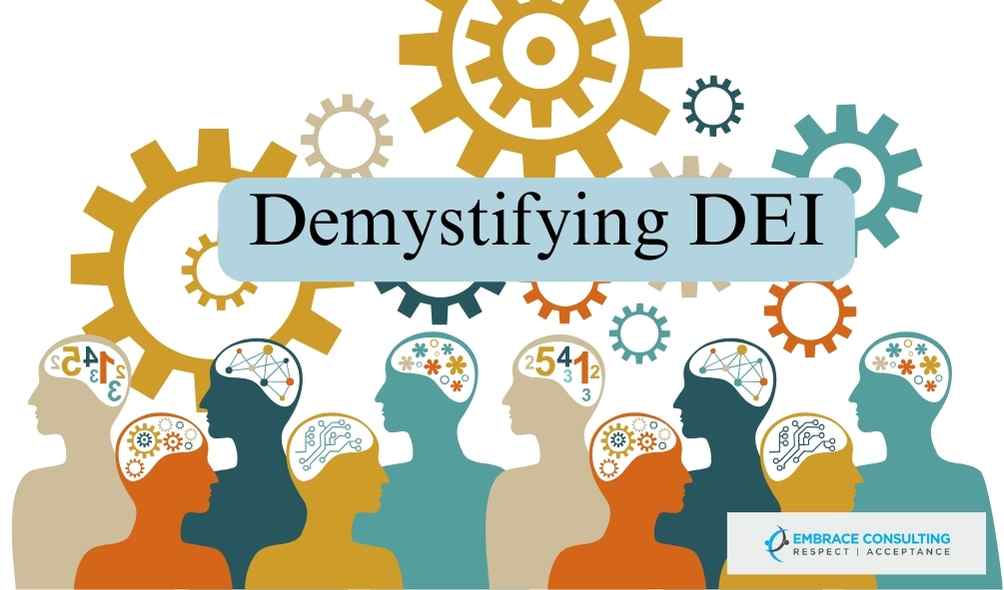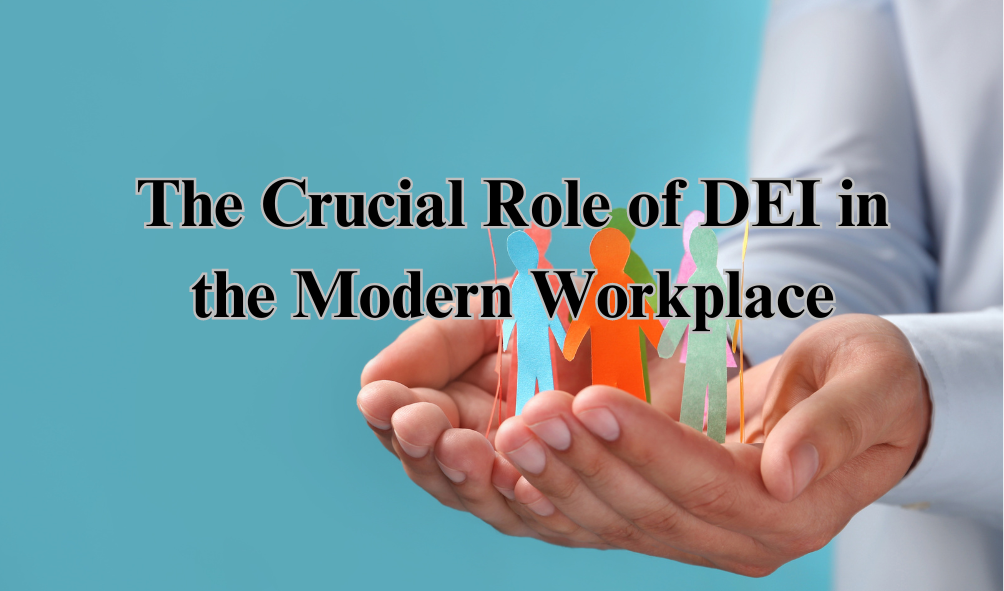ABSTRACT
In the contemporary era, where individuals have started prioritizing their mental health and well-being, it has been observed that potential employees are looking for various job opportunities where the work spaces foster a positive inclusive culture. One that makes them feel safe and as important contributors helps in bringing out their potential to the fullest. On
the other hand even the company leaders have started to recognize the value of creating an inclusive work environment in their teams to foster their employees’ mental and physical well being, not just from the perspective of Corporate Social Responsibility (CSR) but also to enhance the company’s work environment and hence its growth and performance.
INTRODUCTION
Inclusion
Inclusion refers to the practice of creating a work environment where each employee feels valued, respected, and empowered to contribute their ideas and perspectives to the organisation. Inclusion as a concept goes beyond the term of representation and extends out to the active engagement of each employee in the important matters of the company. An Inclusive organisation provides equal opportunities to each of its employees regardless of their differences. Providing a space that is safe, equal and lets its employees celebrate their individual differences by allowing them to bring out their own ideas for career growth and development is essential for creating a diverse and inclusive work culture. Inclusivity in
organisations doesn’t stand for any sort of prejudice and discrimination as it values its employees based on their contributions and merit and not for their identity.
Diversity, Equity, Inclusion and Belonging (DEIB) are four concepts that hold much importance in the recent era for both company leaders and job seekers. It helps in creating a positive and productive atmosphere which contributes to the innovation and growth of a company.
In a 2023 Harvard Business Review article it was stated that employees want their managers to feel at ease talking about DEIB. Both employees and managers believe that there is room for growth in managers’ comfort level when talking about DEI. Only 39% of workers reported having conversations with their management on DEIB in the previous year. This is consistent with the 41% of managers who said they were ready for these discussions. Only 8% of HR leaders, however, stated they thought their managers were ready for these discussions. According to Gallup research, managers who have participated in a listening session, town hall, or company-wide meeting on the subject in the previous 12 months are more than twice as likely to strongly agree that they are prepared to have DEIB dialogues.
Employee Wellness
A survey done by Oracle for a Research Study ruled out that the meaning of success has changed for 88 % of the global workforce since the pandemic, with work-life balance (42%); mental health (37%); and workplace flexibility (33%) now being the top priorities. In the modern day era, there has been a change in the workplace with an increased set of expectations from the employees, new levels of goals and tasks to meet daily and the continuous pressure that comes with it is not sitting well with many aspects of employee wellness. Statistics have ruled out that Work is one of the leading causes of stress for adults in
the United States and job-related stress is linked to poor mental health. These workplace stressors, including long working hours, poor social support, and unclear management and work roles, are connected to increased risk for various negative mental health outcomes. (Ashley Wu, MHS, Enid Chung Roemer, PhD, Karen B. Kent, MPH, David W. Ballard, PsyD, MBA, and Ron Z. Goetzel, PhD)
The overall success of an organisation is completely dependent upon its workforce. Therefore it is necessary that the health and wellness of its employees is an organization’s top priority. Research suggests that there are 4 major pillars to take into consideration when it come to employee well-being :
Physical well-being
This aspect of employee wellness focuses on the promotion of a healthy workforce, one that makes healthy lifestyle choices and strives to become a better version of themselves physically. To support physical wellness, organisations can take various steps like providing access to healthy and nutrition based food choices in the cafeteria, providing various sorts of fitness facilities like gym memberships, yearly health checkups and increasing awareness about the importance of prioritizing physical health through seminars, classes etc.
Financial well-being
Often, stress related to an individual’s financial condition can deeply impact their well-being. Organisations can promote financial well-being for its workforce by providing professional financial assistance through workshops, seminars etc. Offering healthcare benefits through insurance for medical emergencies, financial literacy assistance through helping out with retirement planning as well as offering other financial benefits in the form of bonuses etc.
Social Well-being
When it comes to the social pillar of employee wellness, it aims to recognize how an employee’s environment can impact their overall well-being and how the importance of genuine relationships and connections in the workplace helps create a sense of belonging for the employees. Employers can support the social wellness of their employees through the encouragement of team-building exercises, socialization of the employees outside the work environment through staycations, social events etc.
Mental and Emotional well-being
This Pillar of employee wellness mainly involves the psychological well-being of its employees through stress management, promoting work life balance, and the resilience to cope with difficulties . It is crucial for employees to feel psychologically safe in their places of work. Through employee assistance programmes (EAPs) organisations can offer its employees with access to counselling by mental health professionals, stress reduction as well as management techniques and awareness about the need to prioritize mental health through workshops and seminars. A mentally well workforce of an organisation not only is of benefit to the individual employees but also to the efficiency, productivity and ultimately the overall
success of an organisation.
Connect between the two dimensions :
Now, through the observations of this research we could draw upon the various positive impacts of inclusivity on employee wellness which indicated that a work environment that supports inclusivity improves an employee’s self concept, career aspects, work-life balance, altruism, sense of belonging and also extends out to the reduction of coming into contact with instances of discrimination and harassment. The essence of the LinkedIn article is as below :
● An Enhanced Self Concept: when organisations celebrate the individual differences of each of their employees and value the contributions they make, however big or small towards the company, the employee feels encouraged and valued which tends to enhance their self concept- the set of beliefs and ideas they hold about their own self which increases their self esteem and self efficacy which tends to be of help to the employee and the company as well
● Career Growth: A survey by DCA-Suncorp Inclusion@work observed that employees in inclusive work environments are twice as likely to receive regular career development opportunities and are also ten times more likely to be effective than
workers in non-inclusive work environments.
● Work-life Balance: Inclusive organisations tend to have a flexible pattern of working when it comes to dealing with day to day work which helps to maintain each employee’s work-life balance. A well maintained work-life balance helps an
individual to prioritize both things at once and not prioritize one thing more than the other which could have further serious implications.
● Sense of Belonging: An inclusive work environment has the power to create a sense of belonging in each employee’s life. When employees are made to feel that their ideas and contributions are needed and valued it tends to strengthen their sense of belonging. Inclusivity in workplaces harbors psychological safety in the sense that it manifests a feeling of comfort in the individual so that they feel secure and safe in expressing their ideas, feelings and thoughts without fearing any sort of judgement or discrimination from others which also further creates a sense of belonging in the employee.
● Helping Each Other: When workers are in an inclusive work environment there is a transition from being focused on themselves to working for the team, taking up the “we” mindset. This transition helps in empathizing with each member, helping and working together for shared goals. Prosocial behaviors’ amongst the employees leads to an improved level of productivity and efficiency and ultimately manifests harmony.
● Reduction in Discrimination and Harassment : Research suggests that the lack of inclusion and diversity in an organisation are one of the main causes of increased instances of discrimination, prejudice and harassment. In an organisation, When
people come from different backgrounds such as educational, cultural etc. There are differences in opinion and conflict is bound to arise but it’s not necessary that this conflict is supposed to be negative. Conflict can manifest itself in a healthy manner as well as when employees from all of these different backgrounds come together and express themselves it can open the lines of healthy communication which can lead to more innovative and creative ideas , improved decision making and ultimately also reduce the ingroup bias which society pushes them to adopt. Organisations with such a heterogenous yet inclusive atmosphere foster a positive change which helps in reducing discrimination and harassment.
A Forbes Article examining the connection between Inclusion and Well-Being analyzed that company leaders, managers and colleagues have the capability and power within them to make others feel included, respected, seen and valued by incorporating inclusive behavioral patterns and reinforcing a sense of belonging and suggested key ways to do so such as:
Small yet meaningful exchanges like acknowledging others’ presence through maintaining eye contact, learning and pronouncing their names correctly and giving them your undivided attention when approached and slightly more impactful ways such as inviting them into areas which require decision making and reaching out to the ones who have had minimal to no contribution previously and make them feel visible and recognized.
Leaders need to take accountability when it comes to creating spaces which cater to each of their employees and they need to ask themselves from time to time as to whether they are giving others the stage which allows them to be the best version of themselves; are they creating a work culture which promotes psychological well-being and brings out the
employee’s potential to the fullest
CONCLUSION
In retrospect, we can say that both the concepts of inclusivity and employee wellness might be two independent concepts but they are also interdependent and impact each other and the organisation in various ways. Both of these concepts when put together in a corporate atmosphere promote various dimensions such as, mental health, job satisfaction, and well-being as well as the overall performance and growth of the said organisation. When both inclusivity along with employee wellness are prioritized by the company’s leaders as well as its employees it leads to the formation of a thriving and resilient workforce which has the capability of engaging in creative problem solving and achieving their shared goals. At the
end of the day, It is crucial for organisations to come to terms with the far-reaching impact workplace inclusivity has on the well-being of its employees and incorporate policies and practices to aid the process.
REFERENCES
● Michelle Trudgen. (2023). “Promote Prosocial Behaviour and you improve Inclusivity”. ACTCurious.
● Schneider, F.W., Gruman, A., Coults, L. M. (Eds.). (2012). Applied Social Psychology: Understanding and Addressing Social and Practical Problems. New Delhi: Sage Publications.
● Rayat, S. (2022) . The Powerful Connection Between Inclusion And Well-Being. Forbes
● “Promoting Diversity and Inclusion Through Employee Wellness Programs” : A Strategic Approach. Corporate Wellness Magazine.
● Ashley Wu, et al., (2021). Organisational Best Practices Supporting Mental Health in the Workplace. Volume 63. Wolters Kluwer Health, Inc.
● Aastha Bensla. (2023). 8 ways of creating inclusive work environment at your workplace. Risely.
● Alonso-Nuez MJ, Cañete-Lairla MÁ, García-Madurga MÁ, Gil-Lacruz AI, Gil-Lacruz M, Rosell-Martínez J, Saz-Gil I. Corporate social responsibility and workplace health promotion: A systematic review. Front Psychol. 2022 Oct
13;13:1011879.
● Nisha Nair, Neharika Vohra. (March 2015) Diversity and Inclusion at the Workplace: A Review of Research and Perspectives.
● Jeremie Brecheisen. (2023) Where Employees Think Companies’ DEIB Efforts Are Failing. Diversity and Inclusion. Harvard Business Review.
● Snežana Lazarević, Jelena Lukić Nikolić (2022) IMPORTANCE OF WORKPLACE WELLNESS PROGRAMMES IN PROTECTION OF EMPLOYEE HEALTH.SPORT – Science & Practice, Vol. 11, No2, 2021, pp. 91-98.












